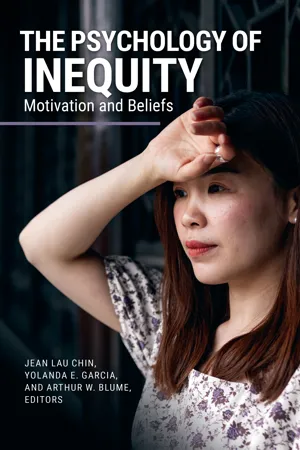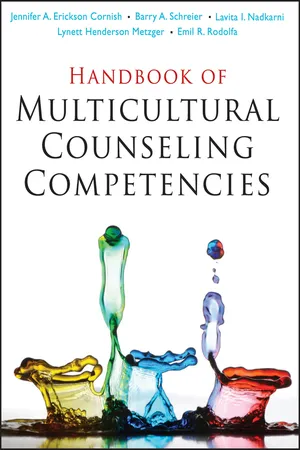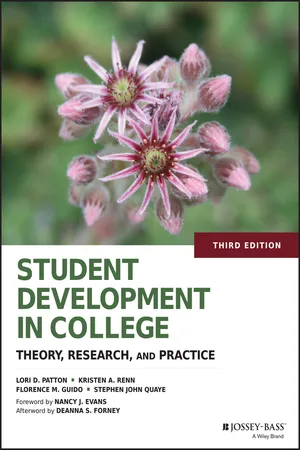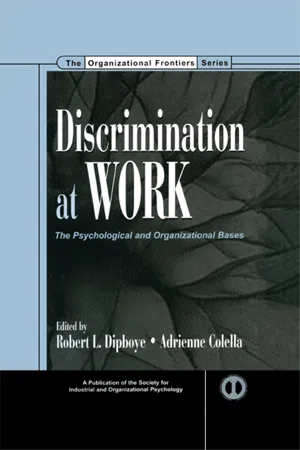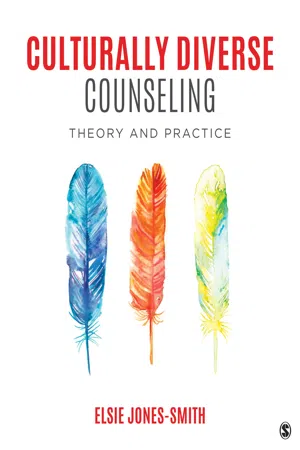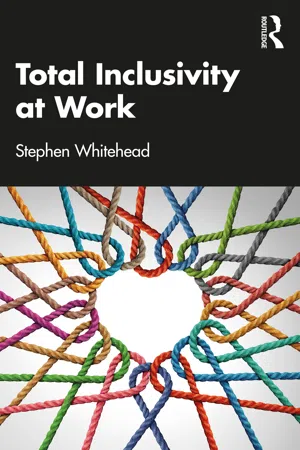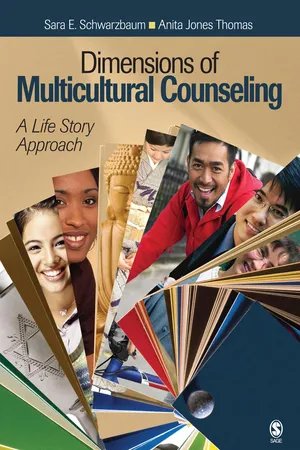Psychology
Privilege
Privilege refers to unearned advantages or benefits that individuals receive based on their social identity, such as race, gender, or socioeconomic status. In psychology, privilege is studied in the context of understanding how it shapes individuals' experiences, opportunities, and interactions with others. Recognizing and addressing privilege is important for promoting equality and social justice within the field of psychology.
Written by Perlego with AI-assistance
Related key terms
Related key terms
1 of 4
Related key terms
1 of 3
8 Key excerpts on "Privilege"
- eBook - ePub
The Psychology of Inequity
Motivation and Beliefs
- Jean Lau Chin, Yolanda E. Garcia, Arthur W. Blume, Jean Lau Chin, Yolanda E. Garcia, Arthur W. Blume, Jean Lau Chin, Yolanda E. Garcia, Arthur W. Blume(Authors)
- 2022(Publication Date)
- Praeger(Publisher)
If oppression is one side of a weighted coin, Privilege is the other, weighted side; Privilege dictates which side lands up (Goodman, 2015; Johnson, 2018). This intrinsic tying of Privilege to oppression can make Privilege seem at first like an interpersonal insult. As such, Privilege is neither an easy nor a natural topic of conversation. Self-identification with Privilege and discussion of its benefits to those who have it could be seen as deliberate risking of that Privilege and its associated benefits (Helms, 2017).Resistance to becoming aware of social Privilege is highest among people who identify strongly with a Privileged social identity because there is more to lose. Stewart and Branscombe (2015) describe the defensiveness that results from being confronted with the prospect of social Privilege as a barrier to awareness of Privilege. From birth, many individuals with Privilege are socialized to avoid shame. Antibias education insists educators should avoid making young children feel guilty or ashamed of their identity. However, collective guilt is actually a “critical ingredient” for reducing intergroup bias through social Privilege awareness (Stewart & Branscombe, 2015, p. 138).WHERE THE RUBBER HITS THE ROAD: FROM THEORY TO APPLICATIONWith the knowledge of what social Privilege is—what it looks like, where to find it, how to describe it—psychologists can begin to understand how social Privilege operates. How does the invisible force of Privilege perpetuate oppression? How can psychologists then self-examine and self-reflect on Privilege to apply the brakes to inequity? Alan Johnson (2018) highlighted the phenomenon that individuals often compare themselves to groups in society that are afforded more of anything that gives those groups greater power and usually neglect to consider groups in society with less. This sort of confirmation bias bolsters the invisibility of social Privilege. Seeing the machinations of social Privilege takes effort. Slowing them down for long enough to intervene takes humility and courage.THE MECHANICS OF SOCIAL PrivilegeIn order for psychologists to intervene in the dynamics of social Privilege, it is necessary to identify the social categories that prescribe these dynamics. Pamela Hays (2001) first conceptualized the ADDRESSING model, an acronym for each social identity domain that influences the dynamics of psychologists’ work. ADDRESSING stands for age, disability, religion and spiritual orientation, ethnic and racial identity, SES, sexual orientation, Indigenous heritage, national origin, and gender identity and sex assigned at birth. Hays recognized the need to explicitly identify each social identity domain and discuss how they are related to either dominant or minority groups. - Jennifer A. Erickson Cornish, Barry A. Schreier, Lavita I. Nadkarni, Lynett Henderson Metzger, Emil R. Rodolfa, Jennifer A. Erickson Cornish, Barry A. Schreier, Lavita I. Nadkarni, Lynett Henderson Metzger, Emil R. Rodolfa(Authors)
- 2010(Publication Date)
- Wiley(Publisher)
This can be a very difficult area for educators, trainers, or supervisors to tackle in class or other training arenas and key issues that make this true will be reviewed in detail. Vignettes will be provided for discussion purposes. Definitions of Privilege and White Privilege Privilege can be defined as “a right, immunity, or benefit granted as a particular benefit, advantage, or favor” (Merriam-Webster, n.d.). Wildman and Davis (2002) identify two key elements of Privilege. First, the characteristics and attributes of the Privileged group are the societal norm and benefit members of the Privileged group. Second, Privileged group members can rely on their Privilege to avoid speaking out against oppression. Cullinan (1999) articulates three presumptions about a dominant cultural group that perpetuate Privilege for that group: innocence, worthiness, and competence. Innocence means that dominant-culture members are generally considered to be without blame, whereas others are viewed suspiciously. The presumption of worthiness means that those in the dominant culture are believed to deserve attention, service, and respect. Competence refers to dominant-culture individuals being treated as competent and given autonomy and encouragement. White Privilege, specifically, is an institutional set of unearned benefits granted to White people (Kendall, 2001, 2006; McIntosh, 1989; Sue, 2003). Sue (2003) defines White Privilege as “unearned advantages and benefits” given to White individuals based on a system that was “normed on the experiences, values, and perceptions” of White individuals (p. 7). McIntosh (1989) characterizes White Privilege as “an invisible package of unearned assets which I can count on cashing in each day, but about which I was ‘meant’ to remain oblivious” (p. 10). She likens it to “an invisible weightless knapsack of special provisions, maps, passports, codebooks, visas, clothes, tools, and blank checks” (p. 10)- eBook - ePub
Student Development in College
Theory, Research, and Practice
- Lori D. Patton, Kristen A. Renn, Florence M. Guido, Stephen John Quaye(Authors)
- 2016(Publication Date)
- Jossey-Bass(Publisher)
Since McIntosh wrote about the invisible knapsack, White Privilege has increased rapidly as a topic for discussion in myriad bodies of literature, including counseling (for example, Israel, 2012; Mindrup, Spray, & Lamberghini-West, 2011), higher education (for example, Cabrera, 2014; Wolfe & Dilworth, 2015), psychology (for example, Case et al., 2012; Sue, 2013), and student affairs (for example, Bondi, 2012; Edwards, Loftin, Nance, Riser, & Smith, 2014). She offered a fitting metaphor for white Privilege, describing it as “a weightless knapsack of special provisions, assurances, tools, maps, guides, codebooks, passports, visas, clothes, compass, emergency gear, and blank checks” (McIntosh, 1989, p. 2).Since the majority of college students in the United States are White, they are the group most often used as subjects in research conducted on campus—in psychology, marketing, medicine, and so forth. They may begin to see themselves reflected back, whereas racially minoritized students may remain invisible to them because, as Tatum (2000) noted, “dominant access to information about subordinants is often limited to stereotypical depictions of the ‘other’” (p. 12). Yet there is also evidence that awareness of white Privilege can be a stepping-stone to anti-racist action; White people can move from “acceptance of oppression to naming oppression (the feeling of guilt), to reflection and redefinition (learning from guilt), to multiperspective integration (to act on what one has learned from guilt)” (Arminio, 2001, pp. 246–247).Social Class Privilege
Socioeconomic status (SES) and social class are related but distinct concepts. Rubin, Denson, Kilpatrick, Matthews, Stehlik, and Zyngier (2014) explained, “SES refers to one's current social and economic situation, and consequently, it is relatively mutable, especially in countries that provide opportunities for economic advancement. In contrast, social class refers to one's sociocultural background and is more stable, typically remaining static across generations” (p. 196). SES and social class influence self-perceptions, attitudes, and behaviors.Social class Privilege attaches to individuals who have a higher socioeconomic status in relation to individuals of lower socioeconomic status. In the United States, “the rich are supported by a general ideology that equates success with hard work and individual merit” (Lott, 2012, p. 654). The ideas that “intelligence and ambition will elevate our socioeconomic position” and that “class Privilege is deserved” (Lott, 2012, p. 654) reinforce the myth of meritocracy and mask the effects of class Privilege. Even in higher education, which may appear to be an engine for promoting social class equity by, for example, conferring degrees on first-generation college students, social class Privilege operates to perpetuate societal inequity (Rubin et al., 2014; Seider, 2008) - eBook - ePub
Discrimination at Work
The Psychological and Organizational Bases
- Robert L. Dipboye, Adrienne Colella, Robert L. Dipboye, Adrienne Colella(Authors)
- 2013(Publication Date)
- Psychology Press(Publisher)
Maier (1997) listed his Privileges as someone who is both male and White. Among the list of Privileges that he acknowledges are, “I am not likely to be restricted from business-related networking opportunities because of my gender (or my race)” and “As a man, at social functions involving partners of organization members; I am not likely to be mistaken for ‘just a spouse’ (and possibly ignored) (pp. 31–32).” An example of a Privilege based upon heterosexuality includes, “Most people I meet will see my marital arrangements as an asset to my life or as a favorable comment on my liability, my competence, or my mental health” (McIntosh, 1993, p. 37).Privilege provides the member of a majority group with resources in organizations that minority group members may not have access to themselves. Privileged personnel in organizations are never considered “different,” but they instead represent what is perceived as normal. It is normal for high-level executives to be White, male, and middle-class. Privileged employees have the opportunity to network and develop productive relationships with one another without the barriers that may be presented when differences in race, gender, culture, or sexuality are introduced. Likewise, Privileged employees, because of their attraction to other Privileged employees, are likely to distance themselves from those who do not have the Privilege of being a part of the status quo. Wildman (1996) commented, “Systems of Privilege and power, by privileging those with certain characteristics or behaviors, are ‘limiting’ individuals who lack those characteristics and behaviors” (p. 33).Allowing unearned Privilege to persist in organizations not only reinforces a system of domination and institutional discrimination, but also may also reinforce interpersonal discrimination. Because differences such as race and gender have been socially constructed to be meaningful in relationship to other attributes such as competence or worth, our group identities not only can become opportunities for Privilege, but also cues for interpersonal discrimination. Interpersonal discrimination reflects one-on-one discrimination that involves avoidance, distancing, and exclusion based upon a person’s group identity (Lott & Maluso, 1995). Social distancing on the part of employees in positions of power toward minority or female targets, likely deny and limit minority and female employees’ access to mentors and to networks that are critical for professional and career development. For example, Dreher and Cox (1996) found that not - eBook - ePub
Culturally Diverse Counseling
Theory and Practice
- Elsie Jones-Smith(Author)
- 2018(Publication Date)
- SAGE Publications, Inc(Publisher)
First, the intersection of PCRW cluster types and attitudes toward White Privilege adds to models for training counseling psychologists in multicultural competencies (see Spanierman, Poteat, Wang, & Oh, 2008, for a review). Second, counseling psychologists can use these frameworks to guide interventions and trainings with students. For example, if a student experiences empathy about racism but lacks accountability, educators may focus on maintaining empathy while exploring guilt and awareness of White Privilege. If a student seems focused on personal costs of confronting White Privilege and self-oriented distress, it may be helpful to focus on building accountable empathy and decreasing fear. (p. 1157)Social Class Privilege
Social class Privilege is often taken for granted, much in the same way that ethnic, racial, or skin color Privilege may not be readily visible to a person who holds that Privilege. For instance, if one is a member of the middle class or the upper class, the Privileges one has may be largely unspoken and invisible.Summary of Multidimensional Privileges In A Society
Every society establishes Privileges to be doled out for some based on certain characteristics and withheld from others because they lack the right skin color, gender identity, social class, religion, or ability. Table 20.5 summarizes key Privileges found in many societies. What Privileges did you experience when growing up? What Privileges do you enjoy right now?Table 20.5 Source: © Elsie Jones-SmithSocial Class and Cultural Strengths: Antidote For Internalized Oppression and Stereotype Threat
Search for the Strengths in the Client’s Culture
Although internalized oppression and stereotype threats may impede a helping relationship, there are ways to offset or to mitigate these forces when working with clients from a broad array of multicultural backgrounds. One way in which a clinician might help clients experiencing the negative effects of Privilege on their lives to change the mental switch to something positive is to ask the clients questions to evoke cultural strengths. For instance, a clinician might ask, “Tell me something about the positive qualities you see about people in your ethnic group, gender, social class, sexual orientation, or religious group. What are the strengths of African American culture? What are the strengths of American Indian, Asian American, or Latino American culture? What makes you proud of being African American, Asian American, American Indian, and so forth? What has been difficult about being African American, a woman, a transgender person, and so forth?” - eBook - ePub
- Stephen Whitehead(Author)
- 2022(Publication Date)
- Routledge(Publisher)
Privileges SevenDOI: 10.4324/9781003244073-7The previous chapter examined what gets in the way of TI. One obstacle deliberately omitted is ‘Privilege’. Why? Because it is such an important, pervasive but contested term that it is deserving of its very own chapter. Very few of us feel Privileged, at least not all of the time. If anything, we are more likely to feel hard done by, marginalised, stressed, disenfranchised, victimised, misunderstood, overworked, unpaid and rarely appreciated for our true worth. Explaining to such a person that maybe they are Privileged in comparison to most others in the world isn’t easy and can quickly lead to denial, rejection or worse. Yet the reality is that some identities are more Privileged than others, even if the person inhabiting that Privileged identity experiences it rather differently. This chapter will delve into the discussion around white Privilege, straight male Privilege and cultural capital Privilege. It will open the door to a greater self-awareness and aims to trigger reflection in the reader as to why their identity mix may be elevated in certain social, organisational and cultural settings and situations. As with every chapter in this book, the discussion will come back to key questions such as ‘why is this the way it is?’ and ‘what can I do to change it, make it better?’To help get started on this discussion the chapter opens with examples of ‘unrecognised Privileges’, because it is important to realise how this feeds discrimination and unconscious bias.Unrecognised Privileges
Several decades ago, I was a Further Education lecturer working in an inner-city college in the north of England. Around half the 1,500 or so students were Black or Asian. At any one time there were an estimated 30 different ethnic and racial groups in the student body, representative of the 80-plus ethnic and racial groups living in the immediate vicinity of the college; it was an area of strong and diverse community links but high levels of unemployment and poverty. Out of more than 200 lecturing staff less than 10% were Black or Asian, and no ethnic minorities were represented at senior management level. 90% of the students were from a Black, Asian or white working-class background. The vast majority of the lecturers were white middle class, male. They worked hard, were stressed, underpaid, insecure, and invariably considered themselves under-appreciated by management. - eBook - ePub
Dimensions of Multicultural Counseling
A Life Story Approach
- Sara E. Schwarzbaum, Anita Jones Thomas(Authors)
- 2008(Publication Date)
- SAGE Publications, Inc(Publisher)
In a system that Privileges some groups and disenfranchises others, differences and diversity are often equated with inequality. However, freedom and diversity are frequently at odds with each other too, and the tensions between them are not always easily resolved (Appiah, 2006). Human variety and diversity matter because people are entitled to options. Different people require different conditions for their development and autonomy. Just as not all plants can exist and grow in the same atmosphere and climate, similarly, what helps one person to grow and self-determine may be a problem for another. A wide range of human conditions are needed in order to allow free people to make choices about their own lives. As much as diversity should not be made to reflect inequalities and oppressive practices, by the same token, diversity cannot be enforced by force, as this also constitutes a form of oppression. A sustainable global ethics, and by extension an ethical psychology, has to strike a balance between a respect for difference with a respect for the freedom of actual human beings to make their own choices (Appiah, 2006).Relationship Between Oppression and Privilege
A complex system of domination and subordination exists in the world that stigmatizes some groups and Privileges others (Adams, 2000c). Influenced by the disciplines of anthropology, sociology, political economy, and feminist theory, among others, authors in the field of multicultural theory have recognized that there are groups that are systematically advantaged and others that are systematically disadvantaged because of their memberships in certain social groups. Male Privilege has been described in the feminist literature for at least three decades (Dolan-Del Vecchio, 1998). Inspired by the ideas related to male Privilege, McIntosh wrote the seminal article on the invisibility of White Privilege (McIntosh, 1998). Since White and male Privilege have been identified as having oppressive effects towards those who do not possess these characteristics, other societal Privileges have been identified, including Christian Privilege (Blumenfeld, 2006), and Privileges afforded by the physically and psychologically able (Castaneda & Peters, 2000), and those who are heterosexual (Miller, 1995), and have more wealth (Liu, 2002), among others. Though descriptions of each type of Privilege’s roots and consequences may differ, there are some ideas that are common to all. First, there is a positive relationship between Privilege and power. The more Privileges a person or a group holds, the higher its power. Second, because the Privileged characteristics tend to be considered the norm against which all others are compared, they are invisible, that is, they are not recognized as Privileges. Finally, people or groups who hold Privileges tend to resist accepting their power in society. That resistance, in turn, makes change difficult, since any change involves loss of power, never easily abdicated. - eBook - ePub
Deconstructing Privilege
Teaching and Learning as Allies in the Classroom
- Kim Case, Kim Case(Authors)
- 2013(Publication Date)
- Routledge(Publisher)
Therefore, the goal of “making Privilege personal” for Privileged students includes two essential aspects. First, students must explore their own social identities to better understand themselves and establish more empathy for others (Ancis & Szymanski, 2001). Second, students must hear personal stories of Privilege and marginalization from others (Soble, Spanierman, & Liao, 2011). By guiding students'124:471 exploration of themselves and others, instructors increase awareness and empathy while reducing defensiveness. Activity: “Who I Am” One classroom activity that helps students explore their own social identities is entitled “Who I Am.” This activity models a classroom exercise described by numerous authors (Bell, Washington, Weinstein, & Love, 1997 ; Case, 2012 ; Griffin, 1997 ; Howard, 2003), where students write an essay about all of their social identities (race/ethnicity, gender, sexual orientation, ability status, socioeconomic status, religion, age, etc.) and the ways those identities relate to Privilege. Students write this essay early in the semester but only after an introduction to Privilege topics such as lists daily white, heterosexual, or male Privileges (McIntosh, 1988). In the essays, students discuss the ways they possess or do not possess Privileges across their social identities. The essay portion of the activity addresses the learning goal of increasing student knowledge and awareness of Privilege, particularly in their personal lives. The instructions below illustrate an example prompt for the assignment: Define and describe as many aspects of your culture and multiple social identities as you feel comfortable disclosing. This may include (but is not limited to) your ethnicity, race, religion, gender identity, sexual orientation, age, socioeconomic status, and ability status
Index pages curate the most relevant extracts from our library of academic textbooks. They’ve been created using an in-house natural language model (NLM), each adding context and meaning to key research topics.
Explore more topic indexes
Explore more topic indexes
1 of 6
Explore more topic indexes
1 of 4
